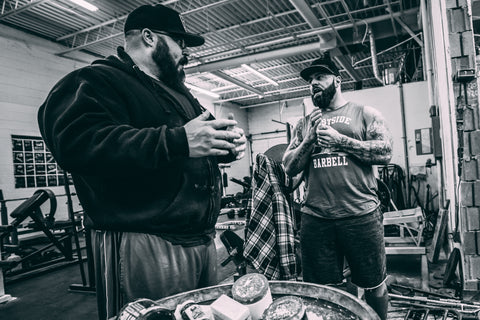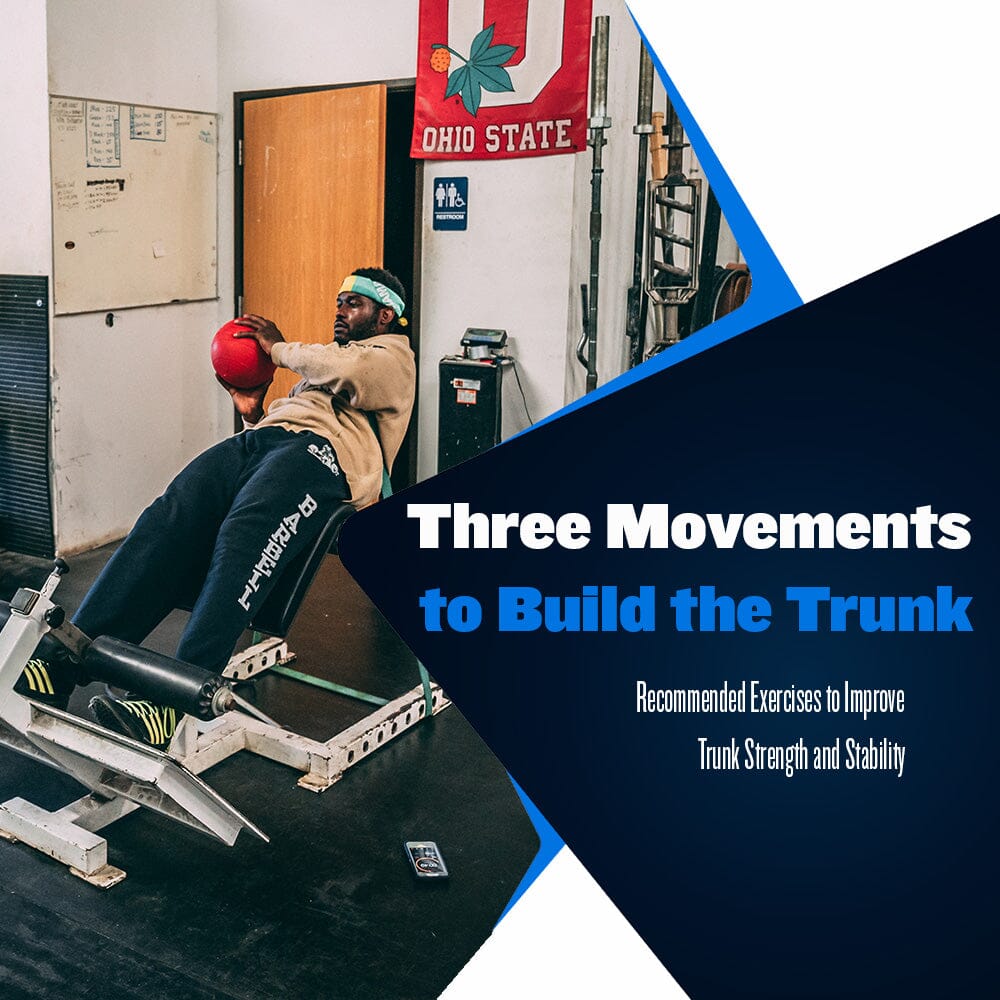Three Movements to Build the Trunk

Whether you are a professional athlete or a hobbyist who enjoys weight training, all humans can benefit from improving the strength of the muscle groups that comprise the torso. Anatomically speaking, these muscle groups are collectively referred to as the trunk muscles. When people hear the term "trunk," they often think of the abdominal muscles. However, the trunk includes both anterior and posterior muscle groups.
The muscle groups that make up the trunk include the chest, back, abdomen, and hip/pelvis muscles. By strengthening these muscles, we can provide increased support and durability to the spine, which protects the athlete and improves sports performance. A stabilized spine will lower the chance of injury and allow an athlete to produce more significant amounts of force by allowing for better nerve conduction.
Additionally, athletes with properly developed trunk strength will benefit from increased balance and stability while avoiding tackles, shooting a takedown, or swinging a golf club. It's simple; no matter what sport you are preparing for, developing a solid trunk will help you perform at a higher level and protect you from injury.
As mentioned above, many believe "trunk" refers to the abdominal muscles. Some may even think you're talking about your car. However, the muscles of the trunk include all of the muscles of the torso. If your athletes only do abdominal exercises to develop the trunk, their preparedness is suboptimal.
Not only do we want to develop strong abdominal muscles, but we also need to develop a strong upper, mid, and lower back, stronger hips, and chest muscles.
So, sticking to the same abdominal-focused training routine will not cut it if the goal is to build durable athletes. Fortunately, if you are following our training advice, you are already performing a multitude of exercises that will help develop the back, hips, and chest, along with the abdominal muscles. However, we highly recommend a few exercises to hone in on the trunk and strengthen the muscles that help protect the spine.
Here are three trunk-building exercises commonly used at Westside Barbell:
Good Mornings
If we are discussing exercises that help develop a stronger trunk, there may be no exercise that can compare to the benefit of good mornings. First, there are many different ways to perform a good morning. We can choose to perform them powerlifting style, as usual, or we can perform them like a bodybuilder and focus strictly on the upper glutes and low back.
Fortunately, no matter how you choose to perform good mornings, this exercise will provide you with valuable training that will improve upper, mid, and lower back and abdominal strength. At Westside, we include a mix of heavy powerlifting-style good mornings and lightweight low-back-focused good mornings.
When performing good mornings as a main exercise, we commonly work up to a top set of three or five repetitions. We want the intensity to be at or above 90%, allowing for the most significant improvements in absolute strength. High-intensity training also improves tissue density, leading to thicker and stronger abdominal and back muscles.
When used as an accessory exercise, repetition ranges vary depending on the training intent. If we want to keep the intensity higher and still use a powerlifting-style good morning stance, we will opt for 3-5 sets of 5-8 reps. If we want to perform a bodybuilding-style good morning and focus more on the low back, abs, and glutes, we will go with 3-5 sets of 12-15 reps.
We recommend featuring both styles of good mornings in your training plan. While loading the trunk with heavy weight improves size and stability, higher volume good mornings will help develop muscular size and working strength, which is just as crucial to an athlete.
GHR Sit-Ups
While we do not want to only focus on our abdominal muscles when targeting trunk strength, the abs are a critical component of the trunk. So, we must target the abdominal muscles using exercises that benefit us most, considering we don't have time for 3-5 abdominal exercises each training day.
GHR sit-ups are a great option for a few reasons. First, the GHR sit-up is an excellent option for directly targeting the abs and trunk. While the abs do most of the work, the other muscle groups of the trunk must help stabilize the torso because the GHR pad only supports the pelvis. This positioning forces the abs to work harder to elevate the torso and causes the remaining trunk muscles to work to keep the body stable.
Additionally, the GHR sit-up can be used to target the hip flexors as well. As mentioned previously, the pad only supports the pelvis, allowing us to go past 180 degrees and stretch the hip flexors and abdominal muscles to a greater degree. Of course, we want to do this within reason, considering overstretching can quickly lead to muscle strain or injury. However, when executed correctly, the GHR sit-up provides excellent abdominal and hip flexor training.
Another benefit of the GHR sit-up range of motion is the ability to extend the range of motion and help alleviate tightness in the intercostal muscles. These muscles exist between the ribs and can often cause an athlete trouble if they become overly tight. To target these muscles, we bring our arms behind our head, similar to a traditional crunch or sit-up form, allowing the rib cage to open up.
When performing GHR sit-ups, we recommend using 4-6 sets of 12-15 or 15-20 reps. If you want to add additional resistance, you can hold a weighted object such as a plate, kettlebell, or medicine ball. You can also add banded resistance by attaching a band around the base of the GHR and wrapping the band around the torso at the chest level.
Russian Twists
If we want to focus on full targeting of the trunk muscles, throwing some transverse plane training into the mix is necessary. So far, we have attacked the entire trunk and focused on the abdominals; now, it is time to add some rotational movement to target the obliques and improve lower back mobility.
Russian twists are a simple exercise that can be executed in many ways. At Westside, we most commonly perform Russian twists seated on a bench or floor and attack different angles using a 45-degree back raise or 180-degree GHR position to improve the strength and endurance of our obliques.
If you are new to Russian twists, we recommend using bodyweight only. This will ensure proper execution is achievable. Once strength improves, we can add resistance similarly to how we did with the GHR sit-ups; by using a plate, kettlebell, dumbbell, medicine ball, or a resistance band.
We recommend beginning with bodyweight Russian twists performing 3-5 sets of 20-30 repetitions. We recommend 3-5 sets of 12-15 reps if resistance is necessary. The resistance should match the rep range, meaning you should use a weight that is heavy enough to challenge you each set, but will allow you to complete all sets and reps with proper form.
Strong Trunk, Strong Athlete
The development of a strong trunk is vital for all humans. For athletes, it is a requirement for sustained success. Not only will a strong trunk provide greater strength and stability, but durability will also improve. This lowers the chance of low back or torso injury and helps extend the career and improve an athlete's overall health.
There is no way around it; if you want to be capable of producing as much force as possible, you must develop a strong trunk. It doesn't matter if you are a pitcher wanting to throw faster, a wrestler wanting to improve your takedown power, or a powerlifter wanting to squat 1000lbs; if the trunk muscles are weak, you will always fall short of your goal.
Whether you're left weak or injured, an undertrained trunk will come back to bite any athlete. Not only will the trunk development pay off in your competitive years, but it will also pay off later in life when your spine is still intact because you built the muscular armor needed to stabilize and protect your spine from damage.
Sources:
Simmons, L. (2007). Westside Barbell Book of Methods. Westside Barbell.
Verkhoshansky, Y., & Siff, M. C. (2009). Supertraining. Verkhoshansky.





